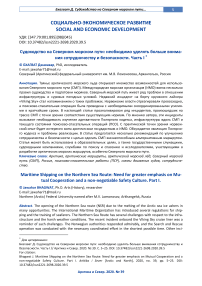Судоходство на северном морском пути: необходимо уделять больше внимания сотрудничеству и безопасности. Часть I
Автор: Бхагват Джавахар
Журнал: Арктика и Север @arcticandnorth
Рубрика: Социально-экономическое развитие
Статья в выпуске: 39, 2020 года.
Бесплатный доступ
Таянье арктического морского льда открывает множество возможностей для использования Северного морского пути (СМП). Международная морская организация (ИМО) ввела несколько правил судоходства и подготовки моряков. Северный морской путь имеет ряд проблем в отношении инфраструктуры и суровых погодных условий. Недавний инцидент на борту круизного лайнера «Viking Sky» стал напоминанием о таких проблемах. Норвежские власти отреагировали превосходно, а поисково-спасательная операция была проведена с необходимыми скоординированными усилиями в кратчайшие сроки. В настоящей статье проанализирован ряд инцидентов, произошедших на трассе СМП с точки зрения соответствия существующим нормам. По мнению автора, эти инциденты вызывают необходимость изучения адекватности Полярного кодекса, инфраструктуры вдоль СМП и текущего состояния поисково-спасательных операций (ПСО). С практической точки зрения норвежский опыт будет интересен всем арктическим государствам и ИМО. Обсуждается эволюция Полярного кодекса и проблемы реализации. В статье предлагается несколько рекомендаций по улучшению сотрудничества и безопасности с целью сделать СМП жизнеспособным альтернативным маршрутом. Статья может быть использована в образовательных целях, а также государственными служащими, судоходными компаниями, службами по поиску и спасению и исследователями, участвующими в разработке арктических морских маршрутов, особенно Северного морского пути.
Арктика, арктические маршруты, арктический морской лёд, северный морской путь (смп), Россия, поисково-спасательные работы (пср), схемы движения судов, сотрудничество
Короткий адрес: https://sciup.org/148310658
IDR: 148310658 | DOI: 10.37482/issn2221-2698.2020.39.5
Список литературы Судоходство на северном морском пути: необходимо уделять больше внимания сотрудничеству и безопасности. Часть I
- Silber G.K., Adams J.D. Vessel operations in the Arctic, 2015-2017. Frontiers in Marine Science, 2019, no. 6:573, p. 314. DOI:10.3389/fmars.2019.00573
- Liu M., Kronbak J. The potential economic viability of using the Northern Sea Route (NSR) as an alternative route between Asia and Europe. Journal of Transport Geography, 2010, vol. 18, iss. 3, pp. 434-444.
- Verny J., Grigentin C. Container strategy in the Arctic: cooperation, not confrontation. The Polar Record, 2017, vol. 53, iss. 3, pp. 107-117.
- Arctic Shipping Marine Assessment 2009 Report. Tromso, 2009, 194 p.
- Tianming G., Erokhin V. China-Russia collaboration in Shipping and Marine engineering as one of the key factors of secure navigation along the NSR. The Arctic Yearbook, Arctic Centre, University of Arctic, 2019, pp. 1-20.
- Strategic Assessment of Development for the Arctic. Lapland, Arctic Centre, University of Lapland, 2014, 143 p.
- Carmel S.M. The cold, hard realities of Arctic shipping. Proceedings, 2013, vol. 139/7/1, pp. 38-41.
- Zhang X. Regional Aspects of the Arctic Ice Silk Road: Case of Heilongjiang Province, China. Handbook of Research on International Collaboration, Economic Development, and Sustainability in the Arctic, IGI Global, 2019, 703 p.
- ABS. Navigating the Northern Sea Route - Status and Guidance. TX: ABS, Houston, 2016, 28 p.
- Franckx E., Boone L. New developments in the Arctic: protecting the marine environment from increased shipping. The Law of the Sea Convention: US accession and globalization. Leiden, Martinus Nijhoff Publ., 2012, pp. 190-205.
- Ostreng W., Eger K.M., F0stad B., J0rgensen-Dahl A., et al. Shipping in Arctic waters: a comparison of the Northeast, Northwest and trans polar passages. Springer Science & Business Media, 2013, 414 p.
- 58 Protection of Arctic Marine Environment. Arctic Shipping Status Report 2013-2019. op.cit.
- Kobzeva M. China's Arctic policy: present and future. The Polar Journal, 2019, vol. 9, iss. 1, pp. 94112.
- Maher P.T., Gelter H., Hillmer-Pegram K., et al. Arctic Tourism: Realities and Possibilities. The Arctic Yearbook. Arctic Centre, University of Arctic, 2014, pp. 1-17.
- Brigham L.W. Perspective - Implementation of the Polar Code. North Pacific Arctic Conference Proceedings. Busan, Korea Maritime Institute; Honolulu: East-West Center, 2015, pp. 175-184.
- Mayorova V., Grishko D., Chagina V., Khardaminova S. Vozmozhnosti ispol'zovaniya dinamicheskikh lokal'nykh sinusoid dlya kratkosrochnogo prognozirovaniya ledovoy obstanovki v prolive Karskie Vo-rota po dannym kosmicheskoy radiolokatsionnoy s"emki [Possibilities of Using Dynamical Local Sinusoids for Short-Term Forecast of Ice Condition in the Kara Gate Strait from Space-Based Radar Imaging]. Vestnik MGTU im. N.E. Baumana. Seriya «Estestvennye nauki» [Herald of the Bauman Moscow State Technical University. Series "Natural Sciences"], 2013, no. 1 (48), pp. 117-128.
- Sergunin A., Konyshev V. Forging Russia's Arctic strategy: actors and decision-making. The Polar Journal, 2019, vol. 9, iss. 1, pp. 1-20.
- Teslya A., Gutman S. Forming and developing a green transport corridor in the Arctic. IOP Publishing in IOP Conference Series: Earth and Environmental Science, 29.01.2020, vol. 434, pp. 1-9. DOI:10.1088/1755-1315/434/1/012010
- Zagorski A. Perspective - Implementation of the Polar Code. North Pacific Arctic Conference Proceedings. Busan, Korea Maritime Institute; Honolulu: East-West Center, 2015, pp. 215-234.
- Nevalainen M., Helle I., Vanhatalo J. Preparing for the unprecedented - towards quantitative oil risk assessment in the Arctic marine areas. Marine Pollution Bulletin, 2017, vol. 114, iss. 1, pp. 90-101.
- Guidelines for Ships Operating in Polar waters. London, International Maritime Organisation, 2010, 22 p.


